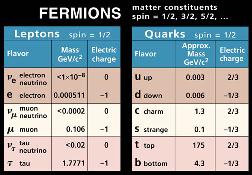Fermions
Fermions are the fundamental particles for everything in the universe. How they are described is: Fermions are particles with a spin of an odd multiple of 1/2 (1/2, 3/2, 5/2).
Two types of basic fermion exist, the quark and the lepton. These fermions are subject to Pauli Exclusion Principle which states that no particle can exist in the same state in the same place at the same time. Quarks and Leptons have something known as "flavor". Flavor is just a name for the type particle of a class. Since all fermions have flavor, they are all subject to interactions with W-, W+, and Z bosons which are the force carriers for the weak force.
The difference between quarks and leptons is that quarks have a color charge (and therefore interact with the strong force) and leptons do not. This means that gluons will react with quarks but not with leptons.
Leptons consist of three flavors of charged particle and a neutral "neutrino" for each flavor of charged particle. Of these 6 lepton particles, only 4 are stable in the universe: electrons, electron neutrinos, muon neutrinos, and tau neutrinos. The other leptons, muons and taus, are more massive than their first generation cousin, the electons, and therefore will decay into a more stable state via the weak force.
Quarks have two different types and three flavors of each type also. There are the quarks with a charge of -1/3 and quarks with the charge 2/3. Of these, the only quarks noted in somewhat stable particles are the up, down, and strange quark. The other quarks (charm, bottom, top) are very unstable and decay very quickly after being created. Quarks are always accompanied by gluons, and are always in sets where their total color charge equals zero. Quarks are what make up hadrons and mesons.
